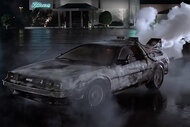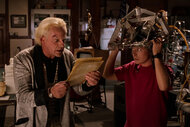Create a free profile to get unlimited access to exclusive videos, sweepstakes, and more!
Doc Brown would be shocked by lightning "superbolts" almost 100 times more powerful than 1.21 gigawatts

If Doc Brown was tinkering with this much energy on his time-traveling DeLorean, he would have probably said something more than Great Scott!
There are lightning bolts, and then there are superbolts that flash up to a thousand times brighter than typical lightning and can produce at least 100 gigawatts of power. They sound like a phenomenon that could have sent Doc and Marty McFly hurtling a lot further back in time than they bargained for in Back to the Future. Superbolts are so bizarre that they don't even follow the rules of lightning formation, doing the inverse instead, and now some that were literally the brightest lightning ever seen in the Americas have been observed.
So forget about starting up a clunky old DeLorean. Superbolts could potentially power things much cooler than vintage car time machines.
“A myriad of lighting processes can produce a superbolt: intracloud pulses and cloud‐to‐ground strokes with a range of peak currents,” said researcher Michael Peterson of Los Alamos National Laboratory, who led two studies recently published in the Journal for Geophysical Research: Atmospheres. However, the absolute brightest cases—at least 1,000 times more energetic than normal—cluster in certain regions known for very large thunderstorms.”
Lightning spawns from electrical charges that spawn in positively charged clouds interact with the ground. Superbolts are rare (think just 5 per every 10 million lightning flashes) because they form from uncommon interactions between negatively charged clouds and the ground. They can also come into being from electrical pulses given off between clouds. It should also be no surprise that lightning with almost preternatural strength can arise from places that are constantly being bombarded with thunderstorms. In these regions, superbolts can manifest as what are now called “megaflashes,” or enormous swaths of lightning that reach across hundreds of miles with their electrifying arms.
When superbolts form over the ocean, they feed off the electrical charges that gradually build up in stormclouds and gain much more power to release when they blaze across the sky. These hulking clouds start as warm, humid air that rises and condenses into water droplets. So long as warm air keeps fueling the cloud, it will grow, and the water droplets will grow with it. Rain is unleashed after water has made the cloud too heavy to float. Downdrafts, or cool dry air blowing downward, will pull raindrops down, as updrafts continue to supply the cloud with warm air, creating an angry cycle known as a thunderstorm cell. You can probably see where this is going.
As warm and cold air continue to whirl inside the cloud, they build up electric charges. Lightning is born from this electricity, so just take that and amplify it many, many times to get an idea of how superbolts arise.
While regular lightning can strike down trees, mess with electrical wires and cause blackouts that might keep you off the internet for days, it is nothing compared to the super-destruction a superbolt can cause. In 1979, a superbolt slammed into South Africa with all the might of a nuclear bomb. It split trees, twisted TV antennas, and basically destroyed most all of the electrical infrastructure in the region. The fact that the total energy of a superbolt peaks over 2 microseconds is deceptive. That is a substantial amount of time for lightning, whose activity can change in a matter of microseconds. Great Scott.
In Peterson’s first study of these literally shocking monsters, he and his team used the Geostationary Lightning Mapper (GLM) sensor, attached to a satellite so it could detect the brightest superbolts it could find. His second study used the Fast On-Orbit Recording of Trnasient Events (FORTE) to determine optimal viewing conditions for gauging the brightness of superbolts. Clouds were an obstruction, but only with dimmer bolts, since the extreme brightness of this type of lightning, pierces through just about everything.
“Some optical superbolts result from favorable viewing conditions and would not be identified as such by another instrument located elsewhere and that others are associated with a unique set of physics that may merit the “superbolt” distinction,” he said.
Could the superpowers of superbolts be harnessed? If so, one can put out enough power to rival the output all the solar panels and wind turbines in the US produce in one year, but don’t expect even that to catapult you to the future.














